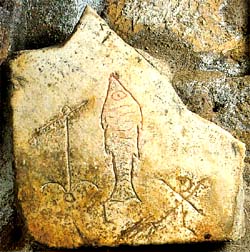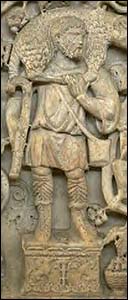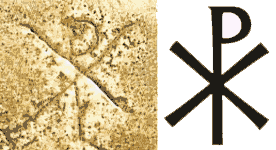
|
Old Testament
New Testament
Gospels
Acts
Paul's Letters
General Letters
Revelation
Topical Studies
Beginning the Journey (for new Christians). en Español

|
Old Testament
New Testament
Gospels
Acts
Paul's Letters
General Letters
Revelation
Topical Studies

|
Home
Bible Studies
Articles
Books
Podcasts
Search
Menu
Donate
About Us
Contact Us
FAQ
Sitemap
Early Christian Symbols in the Catacombs
 Anchor, fish, and Chi-Rho symbols from the Catacombs of St. Sebastian. |
Easter week of 2002 I visited the Catacombs of St. Callixtus in Rome, burial place of tens of thousands of early Christians. Our group descended from the warm air above, down a steep stairway into the cool and musty catacombs several levels beneath the surface. Here were thousands of niches hollowed out in the walls, used for burial from about 150 - 410 AD. Violent persecution of Christians came from time to time. Here lay also the revered tombs of the martyrs.
This underground funereal labyrinth contains some of the very earliest artifacts of Christianity we have. Here Christians mourning their loved ones would express their faith in Christ and his promises. Much of this is done in symbols -- first in words and crude drawings inscribed into soft marble tombstones, later in colorful fresco paintings that adorned special areas. From the fourth century you can see a few elaborately carved sarcophagi commissioned by wealthy believers.
I was fascinated to learn that the symbol of the cross itself was only rarely used in the catacombs. Rather, other symbols are inscribed into thousands of marble tombstones as a testimony to the early Christians' faith in Christ their Savior.
|
|
Chi-Rho. Chi and Rho are the first two letters (ΧΡ) of "Christ" in Greek ΧΡΙΣΤΟΣ. (Christos). Sometimes it is called the Monogram of Christ, Chrismon, or Labarum. It was used very early by persecuted Christians in the catacombs. Later, when Constantine was struggling to become emperor, he lifted this symbol at the front of his victorious armies. Sometimes the Chi-Rho appears with the first and last Greek letters, Alpha (Αα) and Omega (Ωω), a symbol of eternal life in Christ, who is the first and the last, the beginning and the end (Revelation 1:11). The IHS symbol appears very rarely in the catacombs.
|
Fish Symbol . Another common symbol was the fish. Sometimes it depicts men who have been caught by Christ and his apostles ("I will make you fishers of men," Matthew 4:19). But the fish (Greek ichthus), through a Greek acrostic, also became a symbol of Jesus himself, each letter standing for a word that explains who he is. So far in my perusal of catacomb pictures, all the fish seem to have scales, unlike the simple ichthus fish widely used in our day.
Anchor Symbol. A third common item in catacomb symbology is a boat anchor. It expresses the firm expectation of eternal life that we Christians enjoy: "We have this hope as an anchor for the soul, firm and secure" (Hebrews 6:19). The anchor also was used as a disguised cross in a day when the cross itself was seldom used for fear of persecution. The crosspiece or "stock" at the top of the anchor reminded Christians of the cross on which Jesus died.
 Detail of the central shepherd from the intricately carved marble Sarcophagus of the Good Shepherd , Catacomb of Praetextatus, Rome, 390s AD. Full sarcophagus. |
Good Shepherd Symbol. Also very popular is the Good Shepherd, a symbol of Christ's care for his sheep ("I am the Good Shepherd," John 10:11). Sometimes the shepherd is seen carrying a sheep over his shoulders; occasionally the sheep is by his side.
Orante or Praying Figure. A fifth common symbol is of a Christian with arms lifted in prayer and praise, expressing the soul at peace in paradise.
Dove Symbol. Finally, a dove with an olive branch in its mouth appears as a symbol of the peace and happiness of the soul. The olive branch comes from the story of Noah, who after the flood dispatched a dove to find dry land; it finally returned with an olive branch in its mouth as a sign of returning vegetation in a habitable land (Genesis 8:11). Only occasionally in catacomb art does the dove represent as the Holy Spirit, though in later Christian symbology, that is the chief meaning of the dove.
Other symbols appear but not as frequently --
- The peacock as a symbol of eternal life;
- The ship of the church, which, like Noah's ark, carries Christians safely to their eternal destination in heaven;
- Palm branches, a symbol of victory in heaven (Revelation 7:9); and
- Vine, branches and grape clusters ("I am the vine, you are the branches," John 15:1-6).
The cross became the prominent symbol of the faith from the fifth century and beyond, but the catacomb figures described above mark the very earliest symbols of Christianity. You can see many examples of these symbols from the catacombs in my website, Early Christian Symbols from the Catacombs (www.jesuswalk.com/christian-symbols/).
Copyright ©2006, Ralph F. Wilson <pastor@joyfulheart.com>. All rights reserved.
| I give you permission to place this brief article on your church, ministry, or personal website so long as the copyright notice above, the byline, and all the hyperlinks remain. E-mail me and let me know the URL please. |
Copyright © 2026, Ralph F. Wilson. <pastor![]() joyfulheart.com> All rights reserved. A single copy of this article is free. Do not put this on a website. See legal, copyright, and reprint information.
joyfulheart.com> All rights reserved. A single copy of this article is free. Do not put this on a website. See legal, copyright, and reprint information.



 To be notified about future articles, stories, and Bible studies, why don't you subscribe to our free newsletter, The Joyful Heart, by placing your e-mail address in the box below. We respect your
To be notified about future articles, stories, and Bible studies, why don't you subscribe to our free newsletter, The Joyful Heart, by placing your e-mail address in the box below. We respect your